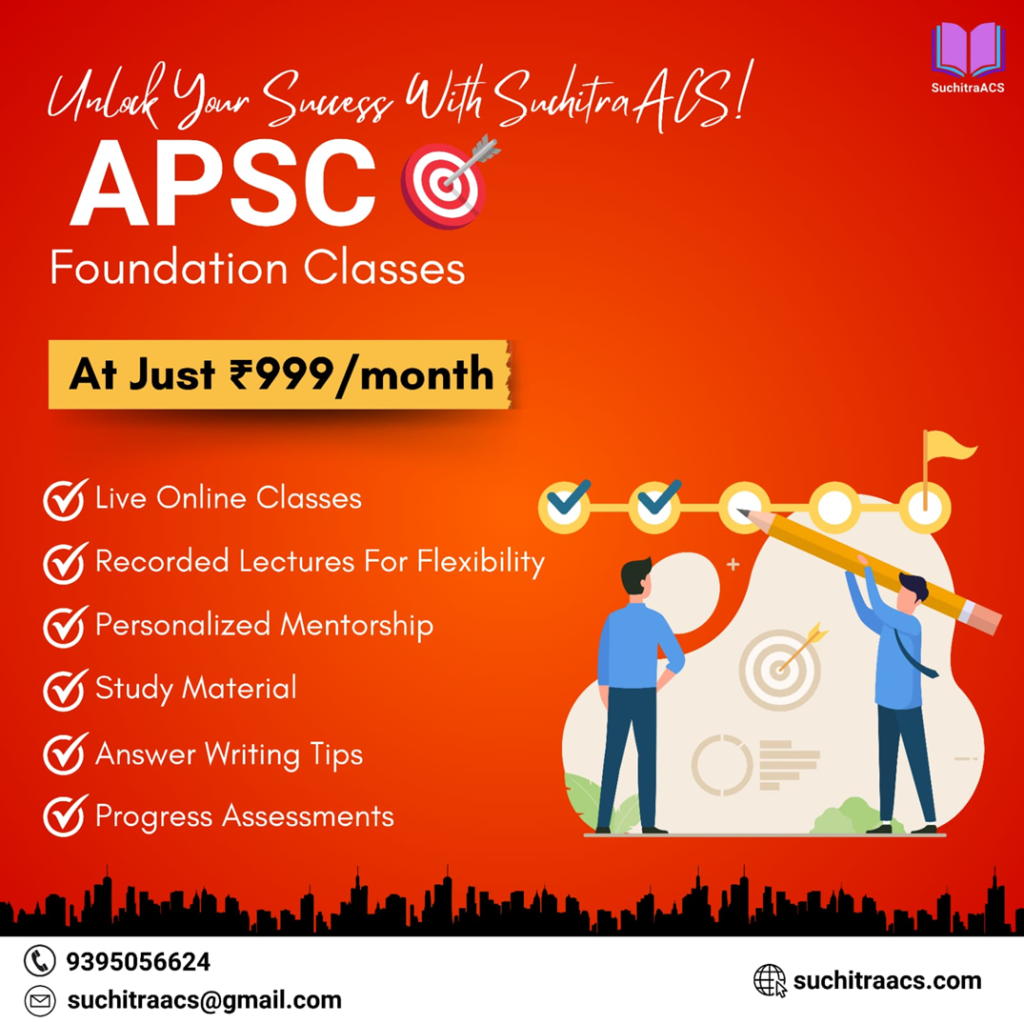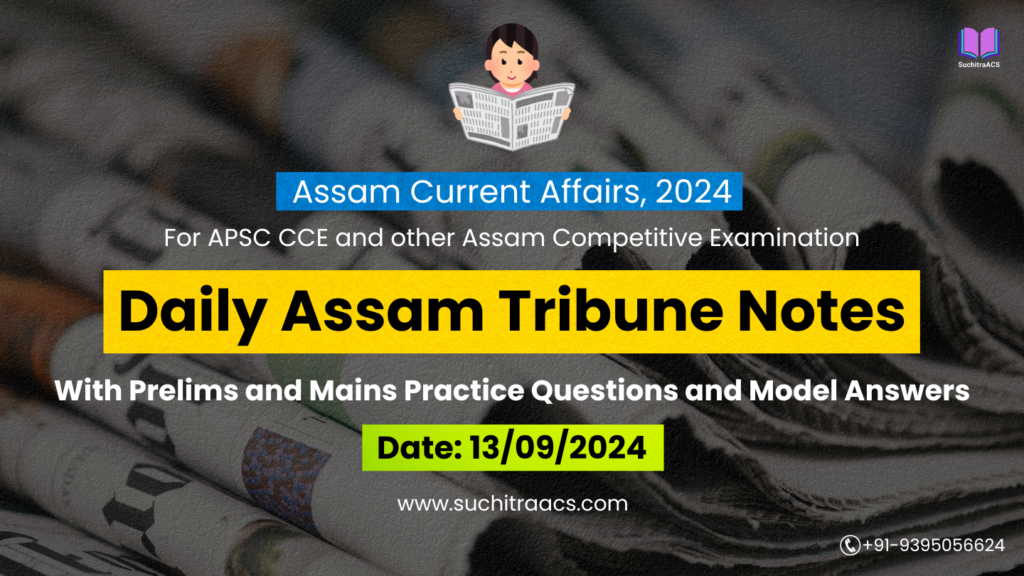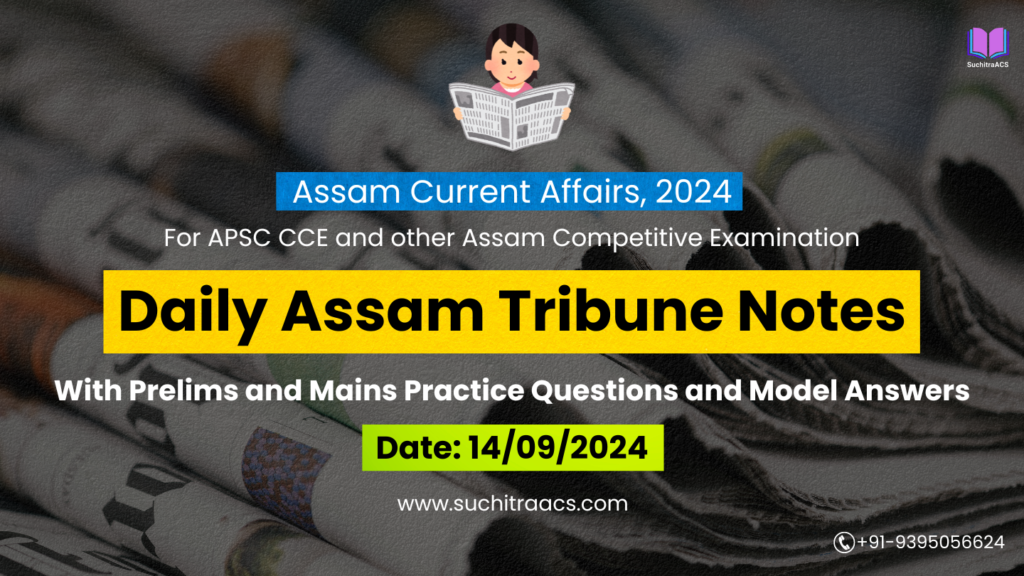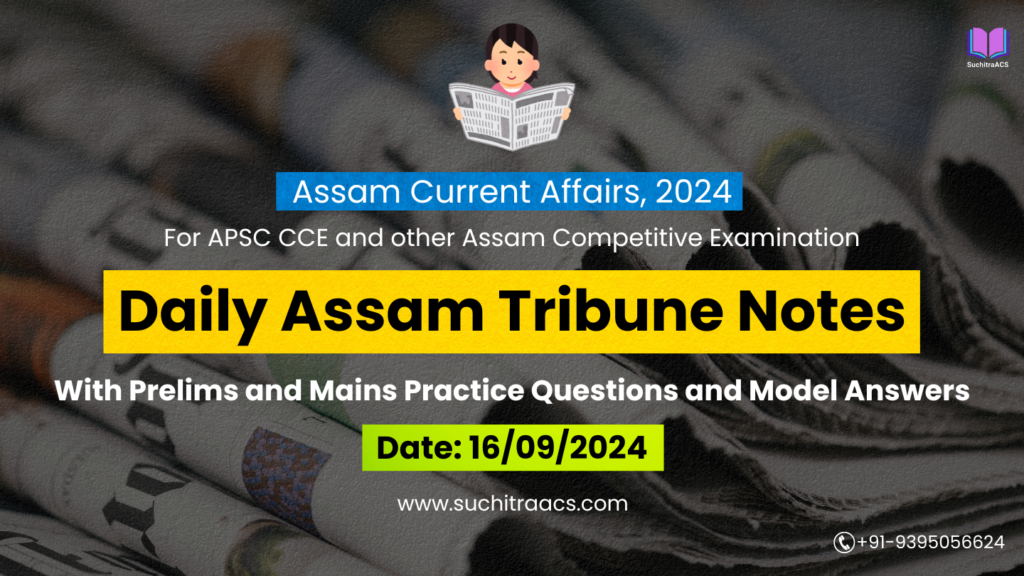APSC Current Affairs: Assam Tribune Notes with MCQs and Answer Writing (16/10/2024)
For APSC CCE and other Assam Competitive examinations aspirants, staying updated with current affairs is vital. This blog covers most important topics from the Assam Tribune today (16-10-2024). These issues are key for both APSC Prelims and Mains preparation, offering insights into the APSC CCE Syllabus.
1. Manipur Peace Talks and the Role of the MHA
- GS Paper II – Governance, Internal Security
- Introduction:
- The Ministry of Home Affairs (MHA) convened a peace dialogue between Meitei, Kuki, and Naga legislators to address the ethnic violence in Manipur, which has resulted in over 220 civilian deaths and displacement of more than 65,000 people.
- Key Points:
- Dialogue Process: The meeting aimed to bridge differences and promote reconciliation among warring communities, including Meitei, Kuki, and Naga groups.
- Role of Stakeholders: Representatives from the Meitei, Kuki-Zo-Hmar, and Naga communities, along with BJP leaders, participated in the talks.
- Outcome of the Meeting: The meeting resulted in a joint appeal for peace and a commitment to continue discussions for a long-term resolution.
- Challenges: Diverging demands, such as the Kuki-Zo community’s call for a separate administration, complicate the peace process.
- Prelims Focus:
- MHA’s Role in Conflict Resolution: Understanding the functions of the Ministry of Home Affairs in maintaining internal security.
- Key Communities in Manipur: Meitei, Kuki, and Naga groups and their significance.
- Conflict Management Strategies: Government strategies for handling ethnic conflicts in India.
- Mains Focus:
- Ethnic Conflicts in the Northeast: The roots of the conflict in Manipur and the historical context.
- Role of Central Government in State Conflicts: How the MHA’s involvement has shaped the peace process in Manipur.
- Challenges in Peacebuilding: Addressing grievances, balancing demands, and ensuring a lasting resolution.
- Conclusion:
- The MHA’s effort to bring conflicting parties to the discussion table marks an important step in restoring stability in Manipur. Continuous dialogue and efforts to meet the communities’ aspirations are crucial for lasting peace.
2. By-Elections in Assam: Electoral Dynamics and Challenges
- GS Paper II – Polity, Elections
- Introduction:
- The Election Commission of India announced the schedule for by-elections in five Assam Legislative Assembly seats, including constituencies like Bongaigaon, Sidli, and Samaguri.
- Key Points:
- Election Schedule:
- Polling will be held on November 13, and counting on November 23.
- The elections will be conducted using the pre-delimitation boundaries and reservation formula.
- Political Context:
- The vacancies arose as MLAs were elected to the Lok Sabha during the General Elections 2024.
- Major parties like the BJP and Congress have announced their strategies, with alliances being crucial in these elections.
- ECI’s Role: The Commission has outlined strict adherence to the Model Code of Conduct (MCC) to ensure free and fair elections.
- Election Schedule:
- Prelims Focus:
- Role of Election Commission: Functions and responsibilities during by-elections.
- Delimitation in Assam: Understanding the process and its impact on constituencies.
- Model Code of Conduct (MCC): Key provisions of the MCC during elections.
- Mains Focus:
- Electoral Challenges in Assam: Analyzing voter turnout, security arrangements, and potential challenges in conducting elections.
- Impact of By-Elections: Implications for the political landscape in Assam, especially regarding coalition dynamics.
- Governance and Transparency: How the ECI ensures adherence to election rules and prevents malpractices.
- Conclusion:
- The upcoming by-elections will be a significant event in Assam’s political calendar, providing insights into the regional dynamics. The Election Commission’s role in maintaining transparency is crucial for strengthening democratic processes in the state.
2. India-Canada Diplomatic Strain
- GS Paper II – International Relations
- Introduction:
- The diplomatic rift between India and Canada has escalated following accusations by Canadian authorities linking Indian officials to the killing of a Sikh separatist leader. This has led to both countries expelling diplomats and further straining bilateral ties.
- Key Points:
- Accusations and Expulsions: Canada accused Indian agents of involvement in the killing of Hardeep Singh Nijjar. India strongly rejected the claims as “absurd” and responded by expelling Canadian diplomats.
- Political Context: The accusations came just before Canadian elections, raising questions about political motivations and the role of the Sikh community in Canada.
- Impact on Bilateral Relations: The tensions have affected trade discussions and people-to-people ties between the countries, with implications for Indian diaspora in Canada.
- Prelims Focus:
- Diplomatic Protocols: Understanding the Vienna Convention on Diplomatic Relations.
- India-Canada Relations: Key areas of cooperation and recent tensions.
- Sikh Diaspora: Their role in Canadian politics and implications for India.
- Mains Focus:
- Impact of Diplomacy on Trade and Security: How strained relations affect bilateral trade agreements and regional security cooperation.
- Diaspora and Foreign Policy: The influence of diaspora communities on diplomatic ties between countries.
- Role of Media and Public Perception: How media narratives shape diplomatic relations.
- Conclusion:
- The diplomatic fallout between India and Canada highlights the complexities of managing international relations. A balanced approach focusing on dialogue and mutual respect is essential for restoring trust and normalcy in the relationship.
3. Assam’s Initiative for Wetland Conservation
- GS Paper III – Environment, Conservation
- Introduction:
- The Assam Government has launched a new initiative aimed at conserving and restoring wetlands in the state. This is part of a broader strategy to protect biodiversity and mitigate the impacts of climate change.
- Key Points:
- Wetland Restoration: The initiative focuses on the restoration of degraded wetlands and improving their water-holding capacity.
- Community Involvement: The program emphasizes the participation of local communities in conservation efforts through awareness campaigns and capacity-building workshops.
- Biodiversity Protection: Assam’s wetlands are home to several endangered species, including migratory birds and aquatic animals. The initiative aims to create a balance between conservation efforts and sustainable livelihoods for those dependent on these ecosystems.
- Government Partnerships: Collaboration with NGOs and international conservation agencies to ensure scientific management and monitoring of wetland health.
- Prelims Focus:
- Wetlands in Assam: Important wetlands like Deepor Beel, Majuli, and their ecological significance.
- Ramsar Convention: Understanding India’s commitments under the Ramsar Convention and its role in wetland conservation.
- Mains Focus:
- Role of Wetlands in Climate Change Mitigation: Discuss the importance of wetlands in carbon sequestration and maintaining water cycles.
- Challenges in Wetland Conservation: Encroachment, pollution, and lack of awareness among local communities.
- Strategies for Effective Conservation: The role of community-led models, eco-tourism, and public-private partnerships.
- Conclusion:
- Assam’s initiative for wetland conservation is a step towards achieving ecological balance and sustainable development. Active community involvement and continuous monitoring are crucial for preserving these vital ecosystems.
4. Assam’s Focus on Health Infrastructure Development
- GS Paper II – Health, Governance
- Introduction:
- The Assam Government has announced new investments to strengthen the healthcare infrastructure in the state, with a focus on primary health centers (PHCs) and district hospitals.
- Key Points:
- Upgrading PHCs: The initiative aims to upgrade existing PHCs with modern diagnostic facilities and better access to medicines, targeting rural areas where access to healthcare is limited.
- Specialized Healthcare: New projects include the establishment of cancer care centers and trauma care units in major district hospitals.
- Health Workforce: The state has also launched a recruitment drive to fill vacancies for doctors, nurses, and technicians in public healthcare facilities.
- Focus on Maternal and Child Health: The government has introduced new schemes for immunization, prenatal care, and nutrition support to improve maternal and child health indicators.
- Prelims Focus:
- National Health Mission (NHM): Understanding its objectives and how Assam implements NHM initiatives.
- Key Health Schemes: Recent health schemes introduced by the Assam Government.
- Mains Focus:
- Challenges in Rural Healthcare: Discuss the issues faced by rural areas in accessing quality healthcare services.
- Impact of Healthcare Infrastructure on Public Health: How improved infrastructure can reduce mortality rates and disease burden.
- Role of Government in Health: Analyze the effectiveness of state-led initiatives in improving the health sector.
- Conclusion:
- Strengthening the healthcare infrastructure in Assam is essential for achieving universal health coverage. With a focus on both infrastructure and human resources, the state is making significant strides toward better health outcomes.
5. Assam’s New Tourism Policy
- GS Paper III – Economy, Tourism
- Introduction:
- The Assam Government has unveiled a new Tourism Policy aimed at promoting sustainable tourism and leveraging the state’s rich cultural and natural heritage to boost the economy.
- Key Points:
- Focus on Eco-Tourism: The policy emphasizes eco-tourism in regions like Kaziranga, Manas, and Majuli, with the aim of preserving natural ecosystems while attracting tourists.
- Incentives for Private Investors: The government has announced tax holidays, subsidies, and land acquisition support to attract private investment in the tourism sector.
- Skill Development Programs: Training programs for tour guides, hospitality staff, and local artisans to enhance the tourism experience and provide employment opportunities.
- Promotion of Cultural Festivals: The policy also aims to promote local festivals, such as Bihu and Doul Utsav, as major tourist attractions.
- Prelims Focus:
- Key Tourist Destinations in Assam: Understanding the significance of Kaziranga, Majuli, Manas, etc.
- Sustainable Tourism: What it means and how it benefits both the economy and environment.
- Mains Focus:
- Role of Tourism in Economic Growth: How tourism can contribute to employment generation and regional development.
- Challenges in Developing the Tourism Sector: Issues such as infrastructure gaps, seasonal dependency, and environmental impact.
- Strategies for Promoting Tourism: The role of public-private partnerships, infrastructure development, and community participation in boosting tourism.
- Conclusion:
- The new Tourism Policy of Assam has the potential to unlock the state’s tourism potential while ensuring sustainability. Effective implementation and community involvement will be key to making Assam a preferred destination for both domestic and international tourists.
6. Assam’s Flood Relief Fund Allocation
The additional flood relief allocation demonstrates the state’s commitment to supporting affected communities. Long-term solutions, including resilient infrastructure, are essential to reducing the impact of future floods.
GS Paper III – Disaster Management, Economy
Introduction:
The Assam Government has allocated additional ₹200 crore towards flood relief and rehabilitation efforts in the state. The funds aim to support the reconstruction of infrastructure and assist families affected by recent floods.
Key Points:
Support for Affected Families: The relief package includes direct cash transfers to families that have lost their homes and crops.
Infrastructure Rehabilitation: The funds will be used to rebuild damaged embankments, roads, and bridges, especially in flood-prone districts.
Collaboration with NDMA: The National Disaster Management Authority (NDMA) is working with state agencies to ensure the effective implementation of relief measures.
Focus on Resilience: Efforts are being made to incorporate flood-resilient infrastructure and early warning systems as part of the rehabilitation process.
Prelims Focus:
Role of NDMA: Understanding the role of the National Disaster Management Authority in disaster relief.
Flood-Prone Districts in Assam: Key areas affected by recurrent flooding.
Mains Focus:
Flood Management Strategies: Discuss the role of relief funds and infrastructure reconstruction in building resilience against floods.
Challenges in Disaster Relief: Issues like delayed fund disbursement, coordination between agencies, and long-term rehabilitation.
Resilient Infrastructure: Importance of building infrastructure that can withstand extreme weather events.
Conclusion:
APSC Prelims Practice Questions
1. Consider the following statements regarding Assam’s new sports policy:
- The policy focuses on providing training and infrastructure support for rural athletes in Assam.
- It includes special financial incentives for athletes who win medals in national and international events.
- The policy restricts the involvement of private investment in sports academies across the state.
Which of the statements given above is/are correct?
(a) 1 and 2 only
(b) 2 and 3 only
(c) 1 and 3 only
(d) 1, 2, and 3
Answer: (a) 1 and 2 only
Explanation:
- Statement 1 is correct. Assam’s new sports policy aims to support rural athletes by providing training and infrastructure development.
- Statement 2 is correct. The policy offers financial incentives to athletes who win medals at national and international events to encourage participation and excellence.
- Statement 3 is incorrect. The policy aims to attract private investment in sports infrastructure and academies rather than restricting it.
2. With reference to Assam’s efforts in promoting bamboo-based industries, consider the following statements:
- The state has introduced tax exemptions for setting up bamboo processing units.
- The initiative aims to promote the use of bamboo in the construction of rural houses.
- Bamboo processing is limited only to traditional handicrafts and has not been expanded to modern industries.
Which of the statements given above is/are correct?
(a) 1 and 2 only
(b) 2 only
(c) 1, 2, and 3
(d) 3 only
Answer: (a) 1 and 2 only
Explanation:
- Statement 1 is correct. Assam has introduced tax exemptions to attract investments in bamboo processing units.
- Statement 2 is correct. The initiative encourages the use of bamboo in constructing rural houses, promoting eco-friendly and sustainable building practices.
- Statement 3 is incorrect. The bamboo initiative in Assam is not limited to traditional handicrafts; it also includes modern applications like furniture, construction materials, and agro-industrial products.
3. Which of the following objectives is a part of the newly announced health insurance scheme by the Assam Government?
(a) Extending insurance coverage only to government employees.
(b) Providing free medical check-ups exclusively for senior citizens.
(c) Covering medical expenses for families below the poverty line (BPL) up to ₹5 lakh.
(d) Focusing solely on urban health infrastructure development.
Answer: (c) Covering medical expenses for families below the poverty line (BPL) up to ₹5 lakh.
Explanation:
The new health insurance scheme by the Assam Government is designed to cover medical expenses up to ₹5 lakh for families below the poverty line (BPL), aiming to provide financial protection against medical costs. The scheme focuses on inclusive coverage rather than just specific demographics or infrastructure.
4. What is a major goal of Assam’s recent partnership with Japan in the field of renewable energy?
(a) Establishing nuclear power plants in Assam.
(b) Developing wind energy farms in urban areas.
(c) Collaborating on solar energy projects and technology transfer.
(d) Promoting coal-based power generation for industrial use.
Answer: (c) Collaborating on solar energy projects and technology transfer.
Explanation:
Assam has partnered with Japan to focus on solar energy projects and technology transfer to enhance the state’s renewable energy capabilities. The collaboration aims to support Assam’s transition towards clean and sustainable energy sources.
5. Consider the following statements regarding Assam’s recent reforms in the state police force:
- The reforms include the introduction of body cameras for all officers on duty.
- Special training programs have been launched to improve the handling of cybercrimes.
- The reforms aim to increase the number of police personnel in rural areas.
Which of the statements given above is/are correct?
(a) 1 and 2 only
(b) 2 and 3 only
(c) 1 and 3 only
(d) 1, 2, and 3
Answer: (d) 1, 2, and 3
Explanation:
- Statement 1 is correct. Assam’s police reforms include the introduction of body cameras to ensure transparency during law enforcement activities.
- Statement 2 is correct. The reforms focus on specialized training for officers to address cybercrime challenges effectively.
- Statement 3 is correct. The reforms also aim to increase police presence in rural areas to ensure better law and order management.
6. Which of the following is a primary focus of the recently launched Assam Skill Development Program?
(a) Promoting traditional agricultural practices.
(b) Training youth in digital skills and emerging technologies.
(c) Providing free textbooks for all higher secondary students.
(d) Enhancing the state’s transport infrastructure.
Answer: (b) Training youth in digital skills and emerging technologies.
Explanation:
The Assam Skill Development Program aims to train the youth in digital skills and emerging technologies such as AI, data analytics, and coding. This program focuses on making the workforce future-ready and enhancing employment opportunities in new-age industries.
APSC Mains Practice Question
Question:
The recent peace talks in Manipur, initiated by the Ministry of Home Affairs (MHA), are seen as a crucial step towards resolving ethnic tensions in the state. Discuss the key challenges faced in achieving lasting peace in Manipur. Also, suggest measures that can be taken to ensure effective reconciliation among the different communities.
(Answer in 250 words)
Model Answer:
Introduction:
The Ministry of Home Affairs (MHA) has initiated peace talks in Manipur involving the Meitei, Kuki, and Naga communities to address the ethnic violence that has plagued the state since May 2023. This dialogue is a critical attempt to rebuild trust among communities and restore stability in the region.
Key Challenges in Achieving Lasting Peace:
- Historical Grievances:
- The Meitei, Kuki, and Naga communities have long-standing historical grievances over issues like land rights, identity, and autonomy, making reconciliation difficult.
- Demand for Separate Administration:
- The Kuki-Zo community’s demand for a separate administration has created a significant divide, with opposition from the Meitei community, complicating efforts for a united solution.
- Displacement and Trauma:
- The conflict has led to the displacement of over 65,000 people and significant psychological trauma among the affected populations, creating barriers to rebuilding trust and cooperation.
- Insurgent Activities and Cross-border Challenges:
- Insurgent groups active along the India-Myanmar border continue to pose a threat to peace, making it challenging to control arms and maintain security in the region.
Measures for Effective Reconciliation:
- Inclusive Dialogue:
- A continuous and inclusive dialogue process involving all stakeholders, including civil society groups, women’s groups, and youth representatives, is essential for building trust.
- Economic Rehabilitation:
- Implementing livelihood programs and economic rehabilitation initiatives for displaced communities can reduce resentment and foster a sense of belonging.
- Strengthening Local Governance:
- Empowering local self-government institutions can ensure that the voices of all communities are heard, providing a platform for addressing local concerns and reducing feelings of marginalization.
- Cross-border Cooperation:
- Enhanced cooperation with Myanmar to control insurgent activities and secure the border will be crucial for long-term peace.
Conclusion:
The peace talks in Manipur represent a vital opportunity for resolving ethnic tensions and ensuring a stable future for the state. However, achieving lasting peace will require addressing deep-rooted grievances, fostering economic development, and ensuring inclusive governance. Only through a multi-faceted approach can lasting reconciliation and peace be achieved.aps and teacher training will be crucial for its successful implementation, enabling Assam to achieve an inclusive and modern education system.
✨ Looking for top-quality APSC online coaching at an affordable price?

🔔 Join Our WhatsApp Study Group!
For exclusive access to premium quality content, including study materials, current affairs, MCQs, and model answers for APSC CCE and other Assam competitive exams.
Click here to join: SuchitraACS Study WhatsApp Group
📚 Want to know more about SuchitraACS’s most affordable courses?
Click here to know more: SuchitraACS Courses for APSC CCE and Assam Competitive Examinations




